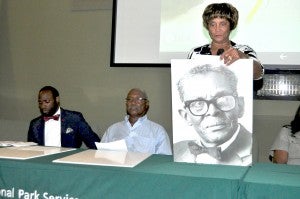Celebrating park service, trail and remembering four Lowndes Countians
Published 6:56 pm Saturday, August 20, 2016
|
Getting your Trinity Audio player ready...
|
By Fred Guarino
The Selma to Montgomery National Historic Trail celebrated the 100th anniversary of the National Park Service, the 10th anniversary of the Lowndes Interpretive Center in White Hall and recognized four Lowndes County African Americans who contributed to the Civil Rights Movement and the Lowndes County community.
The event included an overview of the accomplishments of the Selma to Montgomery National Historic Trail, a review of the Civil Rights Movement and the role of Lowndes County where 90 white families owned 90 percent of the land where the population was 80 percent back. And there was an announcement that other Lowndes Countians could give their oral history.
Robyn Greene-Harris, museum specialist, said, “Today is your opportunity to help us with the oral history that you have” to be used for “research, as well as documentation for films” so that 10 to 100 years later “We’ll have a Selma to Montgomery collection.”
Sandra Taylor, park superintendent for the Tuskegee Institute National Historic Site, the Tuskegee Airmen National Historic Site and the Selma to Montgomery National Historic Trail, told those who crowded into the theater of the Lowndes Interpretive Center that the site celebrated its grand opening on Aug. 26, 2006.
She also said that in 2016, the National Park Service, of which the Selma to Montgomery National Historic Trail is a part, turned 100-years-old.
Taylor said over the past 10 years the Selma to Montgomery National Historic Trail “has stayed true to its purpose” commemorating the people, the events and the route of the Selma to Montgomery Voting Rights March of 1965.
She said the Lowndes Interpretive Center was the first center opened on the trail and was improved with the addition of a conference room.
She said the Selma Interpretive Center was also opened and is being expanded with the help of Congresswoman Terri Sewell for all three stories.
And in recounting other accomplishments, she said a transportation program has been reviewed for U.S. Highway 80, using travel and tourism to move people up and down the trail and the Montgomery site has been finalized, working with Alabama State University to open the third interpretive center in 2017.
Theoplis Hulett, Justin Vaughner, Annie Lawson Lovett and Clifford Jackson were on hand to represent and read the contributions to Lowndes County and the Civil Rights movement by John C. Lawson, John Hulett, Willie Vaughner and Matthew Jackson.
Lawson was a nearly blind minister, farmer and school principal who in 1955 scored more than 90 percent on the literacy test to become the first black registered voter in Hayneville.
Hulett left a job with Alabama Power in 1965 that paid him $30 a month to become a full-time Civil Rights worker and became the first elected black sheriff and probate judge of Lowndes County.
Vaughner was a state trooper, instructor of law enforcement ethics and defensive driving at the State Trooper Academy in Selma and served as Sheriff of Lowndes county for 14 years. He built the new jail and served as chairman of the Lowndes County Friends of the Trail.
Jackson allowed the Student Nonviolent Coordinating Committee (SNCC0 to use an empty home he owned in White Hall to organize. He also offered meals, connections to the community and protection from the violent reprisals of the white population.
According to his biography, “The involvement of Matthew and Emma Jackson and their 10 children offers one of the best examples of the many ways in which personal and family ties were integral to SNCC’s ability to gain a foothold that enabled their organizing efforts to proceed.
Those who read the biographies of their relatives recognized received a special award in those relatives’ honor from the Selma to Montgomery National Historic Trail.

Remembering
Annie Lawson Lovett recites the biography of her father, John C. Lawson of Lowndes County, who became the first black register voter in Hayneville. Lawson and three other Lowndes County African Americans were remembered for their contributions to the Civil Rights Movement in Lowndes County and the community at the Lowndes Interpretive Center in White Hall on Saturday, Aug. 20. The day also marked the National Park Service’s 100th birthday and 10th anniversary celebration of the Lowndes Interpretive Center. Also pictured from left are Justin Vaughner, who represented Willie Vaughner, and Theoplis Hulett, who represented John Hulett. Fred Guarino/Lowndes Signal.





